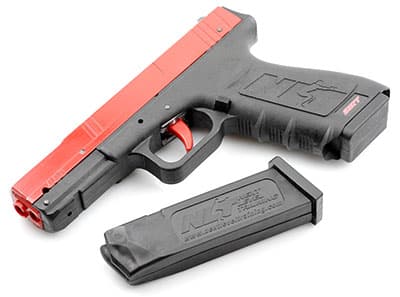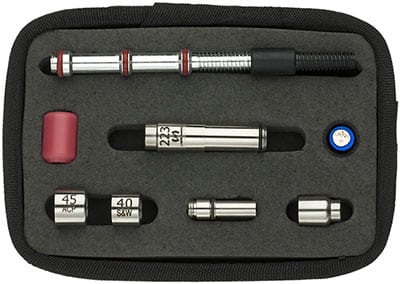Laser Training Device
Laser Range detects visible or invisible laser light fired at the screen from a laser training device. There are two types of training devices that you can use: a dedicated laser training weapon or a laser bullet inserted into a real weapon.

Dedicated Training Weapon
Dedicated laser training weapons are inert devices with Class I eye-safe lasers for hit detection. Inert trainers are non-recoiling but have a realistic look, weight, and feel. One distinct advantage of a dedicated training weapon is that it cannot chamber a live round and therefore is extremely safe. No matter which option you use, you should never have live weapons or ammunition inside a training area.
Several manufacturers make laser training weapons that work well with Laser Range including Next Level Training, Smart Firearms, and SimGuns.
The Laser Range Complete system comes with your choice of a SIRT 110 (GLOCK form factor) with polymer slider and infrared laser or Laser Ammo laser bullet kit.
Laser Bullets
Laser bullets are designed to be used in any semi-automatic pistol. When you dry fire, the weapon’s firing pin strikes the back of the laser bullet which causes it to emit a quick burst of visible or invisible laser light.
When using a laser bullet, extra caution should be taken that live ammunition is never in or around a training gun or facility.
The Laser Range Complete system comes with your choice of a Laser Ammo infrared laser bullet kit with support for 9mm, 40cal, 45cal, and 223 or SIRT 110 (GLOCK form factor) with polymer slider and infrared laser.

Laser Compatibility
Lasers used for training and simulation have two defining characteristics: wavelength and pulse length. Make sure that your training weapon is compatible with Laser Range by following these simple guidelines.
Wavelength – simply put, this is the color of the laser. Laser Range supports red and infrared lasers with wavelengths of 635-850 nanometers (nm). Laser Range does not support green lasers.
Pulse Length – when a laser is activated, it flashes (or pulses) for a brief moment. This amount of time is what is known as the pulse length. The Laser Range camera can capture lasers with pulse lengths of 50 milliseconds (ms) or higher. This includes almost all commercial laser training weapons.
Ideally, your laser training weapon should be an invisible laser with a wavelength between 720-850 nm and a pulse length of 64 ms.
